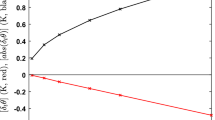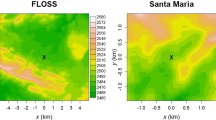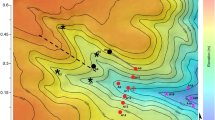Abstract
Two networks of meteorological stations are used to investigate the spatial variability of temperature, wind speed, turbulent kinetic energy, turbulent fluxes and turbulent spectra over horizontal distances of tens to hundreds of metres . The networks are located in regions of moderately complex terrain, with stations located at elevation differences as large as 37 m at Pedras Altas and 10 m at Santa Maria. The spatial temperature variability is largely enhanced on very stable, weak-wind nights. At Pedras Altas, the temperature difference reaches 12 K between stations horizontally separated by less than 500 m. Obstacles also play an important role, as obstructed sites may have temperatures a few K lower than unobstructed sites at the same elevation. The maximum wind speed over the network (Vmax) controls the horizontal variability of mean and turbulent quantities. Despite the terrain and horizontal scale differences, variables such as mean temperature, standard deviations of horizontal and vertical wind components and the turbulent fluxes of sensible heat, latent heat and carbon dioxide share the dependence on Vmax at both sites. The regime transition between the very stable and weakly-stable boundary layers occurs at much lower wind speeds at an obstructed site than at a hilltop.












Similar content being viewed by others
References
Acevedo OC, Fitzjarrald DR (2001) The early evening surface-layer transition: temporal and spatial variability. J Atmos Sci 58(9):2650–2667
Acevedo OC, Fitzjarrald DR (2003) In the core of the night-Effects of intermittent mixing on a horizontally heterogeneous surface. Boundary-Layer Meteorol 106(1):1–33
Acevedo OC, Costa FD, Oliveira PES, Puhales FS, Degrazia GA, Robert DR (2014) The influence of submeso processes on stable boundary layer similarity relationships. J Atmos Sci 71(12):207–225
Acevedo OC, Mahrt L, Puhales FS, Costa FD, Medeiros LE, Degrazia GA (2016) Contrasting structures between the decoupled and coupled states of the stable boundary layer. Q J R Meteorol Soc 142(10):693–702
Arduini G, Staquet C, Chemel C (2016) Interactions between the nighttime valley-wind system and a developing cold-air pool. Boundary-Layer Meteorol 161:49–72
Bodine D, Klein PM, Arms SC, Shapiro A (2009) Variability of surface air temperature over gently sloped terrain. J Appl Meteorol Climatol 48(6):1117–1141
Burns P, Chemel C (2014) Evolution of cold-air-pooling processes in complex terrain. Boundary-Layer Meteorol 150(3):423–447
Derbyshire SH (1995) Stable boundary layers: observations, models and variability part II: data analysis and averaging effects. Boundary-Layer Meteorol 75(7):1–24
Fujita TT, Wakimoto RM (1982) Effects of miso- and mesoscale obstructions on PAM winds obtained during the project NIMROD. J Appl Meteorol 21:840–858
Geiger R, Aron RH, Todhunter P (1995) The climate near the ground. Vieweg, Braunschweig
Gustavsson T, Karlsson M, Bogren J, Lindqvist S (1998) Development of temperature patterns during clear nights. J Appl Meteorol 37(6):559–571
Howell JF, Mahrt L (1997) Multiresolution flux decomposition. Boundary-Layer Meteorol 83:117–137
Klein PM, Hu XM, Xue M (2014) Impacts of mixing processes in nocturnal atmospheric boundary layer on urban ozone concentrations. Boundary-Layer Meteorol 150(1):107–130
LeMone MA, Ikeda K, Grossman RL, Rotach MW (2003) Horizontal variability of 2-m temperature at night during CASES-97. J Atmos Sci 60(10):2431–2449
Lengfeld K, Ament F (2012) Observing local-scale variability of near-surface temperature and humidity using a wireless sensor network. J Appl Meteorol Climatol 51(1):30–41
Mahrt L (1987) Grid-averaged surface fluxes. Mon Weather Rev 115(8):1550–1560
Mahrt L (1999) Stratified atmospheric boundary layers. Boundary-Layer Meteorol 90(3):375–396
Mahrt L (2006) Variation of surface air temperature in complex terrain. J Appl Meteorol Climatol 45:1481–1493
Mahrt L (2011) The near-calm stable boundary layer. Boundary-Layer Meteorol 140:343–360
Mahrt L (2017) Stably stratified flow in a shallow valley. Boundary-Layer Meteorol 162(1):1–20
Mahrt L, Heald R (2015) Common marginal cold pools. J Appl Meteorol Climatol 54:339–351
Mallat S (1989) A theory for multiresolution signal decomposition: the wavelet representation. IEEE Trans Pattern Anal Mach Intell 11(7):674–693
Medeiros LE, Fitzjarrald DR (2014) Stable boundary-layer in complex terrain. Part I: linking fluxes and intermittency to an average stability index. J Appl Meteorol Climatol 53(9):2196–2215
Medeiros LE, Fitzjarrald DR (2015) Stable boundary-layer in complex terrain Part II geometrical and shelteringeffects on mixing. Appl Meteorol Climatol 54(1):170–188
Mortarini L, Cava D, Giostra U, Acevedo OC, Nogueira LGM, Oliveira PES, Anfossi D (2018) Observations of submeso motions and intermittent turbulent mixing across a low level jet with a 132-m tower. Q J R Meteorol Soc 144:172–183. https://doi.org/10.1002/qj.3192
Prévôt ASH, Dommen J, Bäumle M, Furger M (2000) Diurnal variations of volatile organic compounds and local circulation systems in an Alpine valley. Atmos Environ 34:1413–1423
Soler M, Infante C, Buenestado P, Mahrt L (2002) Observations of nocturnal drainage flow in a shallow gully. Boundary-Layer Meteorol 105(2):253–273
Sun J, Mahrt L, Banta RM, Pichugina YL (2012) Turbulence regimes and turbulence intermittency in the stable boundary layer during CASES-99. J Atmos Sci 69(1):338–351
Van de Wiel BJH, Moene AF, Jonker HJJ, Bass P, Basu S, Donda JMM, Sun J, Holtslag AAM (2012) The minimum wind speed for sustainable turbulence in the nocturnal boundary layer. J Atmos Sci 69(11):3116–3127
Van de Wiel BJH, Vignon E, Baas P, Van Hooijdonk IGS, Van der Linden SJA, Van Hooft JA, Bosveld FC, De Rood SR, Moene AF, Genthon C (2017) Regime transitions in near-surface temperature inversions: a conceptual model. J Atmos Sci 74(3):1057–1073
Vickers D, Mahrt L (2006) A solution for flux contamination by mesoscale motions with very weak turbulence. Boundary-Layer Meteorol 118:431–447
Vickers D, Thomas CK (2013) Some aspects of the turbulence kinetic energy and fluxes above and beneath a tall open pine forest canopy. Agric For Meteorol 181:143–151
Wolfson MM, Fujita TT (1989) Correcting wind speed measurements for site obstructions. J Atmos Oceanic Technol 6:343–352
Acknowledgements
The experimental campaigns have been supported by Conselho Nacional de Desenvolvimento Científico e Tecnológico (CNPq) through Project 477251/2010-2. The authors also thank CNPq and CAPES for financial support. Suggestions from Margaret LeMone and two anonymous reviewers are largely appreciated as they improved both the description and the analysis.
Author information
Authors and Affiliations
Corresponding author
Rights and permissions
About this article
Cite this article
Guerra, V.S., Acevedo, O.C., Medeiros, L.E. et al. Small-Scale Horizontal Variability of Mean and Turbulent Quantities in the Nocturnal Boundary Layer. Boundary-Layer Meteorol 169, 395–411 (2018). https://doi.org/10.1007/s10546-018-0381-3
Received:
Accepted:
Published:
Issue Date:
DOI: https://doi.org/10.1007/s10546-018-0381-3




